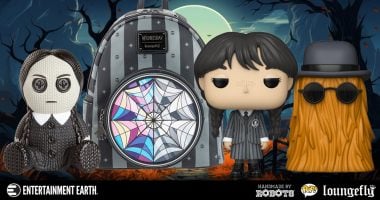When it came to toy sales in the late 1970s and early ’80s, Kenner’s Star Wars line had the Force. But for five amazing years, from 1982-1986, Mattel’s Masters of the Universe brand had the power!
Episode 3 of Netflix’s documentary series The Toys That Made Us is a giddy, gleeful celebration of He-Man, Skeletor, She-Ra, and their fellow denizens of Eternia and Etheria, in all their weirdness and wackiness. Watching this episode is a tremendous amount of fun.
And I say that as one who has not ever stormed the great plastic gates of Castle Grayskull. I’d aged out of He-Man’s target demographic by the time the hypermuscular hero burst onto toy store shelves in early 1982. But boys half my age, the five-year-olds for whom Mattel created him, embraced this stocky, solid-footed, super-sculpted action figure and his wildly colorful, adventurous world with enthusiasm that shines through every minute of this episode.
He-Man, Master of the Toy Universe?
Having passed on the chance to make Star Wars toys (as mentioned in this series’ first episode), toy manufacturing giant Mattel needed a hit in order to stay competitive in the lucrative boys’ toy market. Designer Roger Sweet, production artist Mark Taylor, and the rest of the He-Man team certainly delivered… even if, as this episode entertainingly makes clear, some dispute over who deserves the Battle Cat’s share of the credit for creating the character persists.
Expected to move $13 million worth of merchandise in its first year, the Masters of the Universe line sold almost three times that much, $38 million. And the products’ profits would ultimately climb to a height of $400 million in 1986. In his prime, He-Man was outselling Mattel’s other big star, Barbie herself.
Built for Success
Why this superheroic level of success? The episode points to several reasons. The 5 1/2-inch figures’ chunky physiques made them fit very young children’s hands better than the small, slim 3 3/4-inch Star Wars figures did.
Also, unlike their competition from Kenner, He-Man and company didn’t stand stiffly at attention with blank faces. They stood in action-packed poses inspired by sources as diverse as Frank Frazetta fantasy paintings and old Charles Atlas bodybuilding ads, their faces full of feeling.
The Filmation animated series He-Man and the Masters of the Universe helped secure these toys’ place in pop culture, of course. Critics, educators, and parents complained the cartoon was on the air solely to sell the toys, but it turns out they were more right than they knew. The series only existed because it, like the miniature comic books packaged with the figures, was a last-minute, off-the-cuff pitch to convince Child World retail stores to carry the line.
(In this episode, several vintage animated clips and sincere tributes from adults with fond memories of the show suggest the series also “sold” a basic, decent moral code that would still serve us all well.)
The Power of Wish Fulfillment
But the real secret of He-Man’s success was no secret at all. As his creators freely acknowledge, they took the character’s raison d’être straight from Mattel’s market research. As focus groups of five-year-old boys played with their toys, they inevitably shouted variations on what became He-Man’s famous battle catchphrase: “I have the power!”
Little children – not boys alone; Mattel created She-Ra, we learn because some 20% of the Masters of the Universe market was female – pretend to be big when they play. They pretend to be “lords” (and ladies) “of power” (the brand’s initial name, rejected for sounding “too religious”).
And it’s a wish that, no matter how big we get, never quite goes away. That’s one reason, as the episode shows near its end, that toy and collectible manufacturer Super 7 has found a ready market for modern Masters of the Universe merchandise.
Sometimes, sadly, our desire to “have the power” leads us to hurt others, or to hurt ourselves. But when we can channel that desire into healthy, carefree, creative play, as the Masters of the Universe toys equipped so many kids of the ’80s to do, we can unlock levels of adventure and fun in life we might never have otherwise.










